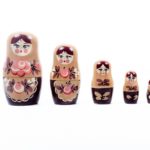By Trish Brown, co-director of Dru Yoga Australia
If you have ever suspected that there was more to you than just your physical body, yoga philosophy reveals that you are right.
According to ancient yoga texts, we are indeed much more than just the physical, being made up of five distinct layers known as the koshas.
The koshas are often compared to the layers of an onion. If you can see the physical body as the outer layer, traveling inwards through more subtle layers of energy, emotion and thought (intellect), we reach the centre or soul layer where lies the elusive experience of bliss.
Each of these layers of our awareness profoundly affects the other and all layers are important for our health and well-being. This is why yoga guides us to firstly know what and where they are, and secondly, how we can work with them effectively.
In any given situation, we have the choice to respond to whatever is happening around us wisely or unwisely and the difference in outcome will be great.
For example, when Mahatma Gandhi was thrown off a train in South Africa because of the colour of his skin. He responded with a skilful use of every one of these vital layers of awareness.
He immediately saw an unjust situation, which had he responded from his emotional layer (manomaya kosha), could have led to violence and retaliation. Instead, he skillfully activated his intellectual layer or vijnanamaya kosha, using discrimination to direct his sense of injustice. He began a campaign to fight for equality and justice for his people, which led to his becoming one of the greatest non-violent freedom fighters of all time.
Gandhi spent the night questioning within the layer of his discrimination, comparing the insights generated from his layer of connectedness, with the evidence before his eyes and made a conclusion that would be a turning point in history. He would fight for equality and justice.
He began to harness every part of his energy and his physical capacity to this cause. It led him to become one of the greatest peace warriors.
Now we may not want to become freedom fighters, but we do all want to be able to respond skillfully in every situation.
So how can we work with the koshas consciously in a very practical way to help us to make the right choices and decisions that lead us towards great outcomes, as opposed to disasters?
First of all it helps to know about them!
If we can be aware of the five koshas we can work towards attaining a harmony between them in order to truly balance out the needs between mind, body and soul.
If your physical body (physical layer) is unwell for instance, it will affect the way you breathe (energy layer) which in turn affects emotions (mental layer) causing the mind (intellectual layer) to become clouded and lacking in discrimination.
Let’s start with the physical body as that is the part of us we all know well and love, known in yoga as the annamaya kosha, the densest layer.
Yoga uses postures that combine balance, strength, and body awareness to connect us to this kosha. Anna means food in Sanskrit and so food is very important to the physical body and should be looked upon as its main fertilizer. Excellent nutrition therefore is crucial for the body to function to its optimum capacity.
Regular well chosen movements in the form of postures (asanas), sequences, relaxation and the physical aspect of breathing contribute to enhancing and balancing the annamaya kosha.
What is the next main fuel for a physical body? This next more subtle layer, is called the pranamaya kosha, which relates to the creation of energy through the breath.
Prana is vital life force and is so vital that, if our breath body or pranamaya kosha, were to stop working, our physical body would simply die. Pranayama, the system of breathing techniques taught in yoga, improves the quality of this vitalising layer.
Yoga helps us to establish a firm familiarity with our physical body and pranayama exercises help us to develop an awareness of the breath. By exploring our breath we gain access to a great river of energy or prana within the physical body. The way we breathe has a strong effect upon this system and it is our breath in fact, that intimately adjusts our physiological responses to stress.
Also associated with this kosha are sensations and our connection to “light”, which all have an energy component.
In Dru Yoga we involve visualizing light moving in the body during the practice of sequences and postures. This has a particular connection with the chakras too. It enables the yogi to create transformation in the mind allowing healing and attitudinal change.
Now we are in a physical body with awareness of the energetic body. Next we bring in the manamaya kosha, or advance towards the emotional layer.
This layer is more subtle and relates to the mind (manas), the sensory and emotional mind (not the brain as a physical organ). This is the place where our motivating thoughts and emotions all originate from and reside. It is where we process the data we collect from the world and our daily experiences via the five senses. This will include emotions, memories, and other uses of the brain.
Predominantly manamaya relates to our individual motivational thoughts, both reactive as well as empowering. Breath creates the bridge between this part of our mind and the body. The state of the body affects our ability to process our reactions to the world around us.
When we consciously choose to engage enthusiastically in life, in our daily activities, and this definitely includes our yoga practice, we naturally entrain our emotions to work for us positively. It is the known principle of E-motion – energy in motion!
Sequences can have a profound transformative effect on our emotions.
For instance Surya Namaskara (sun salutation) uplifts and awakens enthusiasm; Prithvi Namaskara (earth salutation) soothes and settles the mind; while Chandra Namaskara (moon salutation) creates a quiet peaceful inner stillness. Mantra and meditation are also valuable tools that allow the monkey mind to rest and combined with silence, soften the tension that can build up in the mind.
Even more subtle than the emotional/motivational layer is vijnanamaya kosha which is connected to our discriminating intellect.
“Jnana” part of the word vijnanamaya means wisdom or knowledge and this kosha is often referred to as the “wisdom body”. Balancing this kosha involves realizing that we are creative and evolving beings who are constantly learning and changing.
In yoga, the intellect (buddhi) and the mind (manas) are two distinctly different layers, yet both are aspects of our physiological make up. Buddhi, the awakened nature of intellect and deep inner willpower is expressed as the discriminating mind. This is where we have sincere connection with our innermost “knowings”.
This is the part of our mind in where we hold beliefs about ourselves.
We can walk along the street thinking, ‘I’m useless, I’m no good’, following an old program, thought pattern from childhood, perhaps. Or we can walk along the street noticing the beauty about us, while we inwardly affirm “I am a confident and compassionate person” and also thinking of great ideas for adding to our world – magic moments in our relationship, with our children, new work projects; feeling good about ourselves. Believing that the world is a great place to be in and we make a difference within it.
Both are beliefs, but imagine the difference in quality of life and health for people running these two different paradigms of “mind talk”!
This fact is so important that it could be said that much of modern dis-ease originates from negative beliefs in our unconscious. These create massive forces within our emotional body, which in turn generate vast turbulence in our energy system and dis-ease in our physical body.
We have a perfect example of this in our Dru Yoga teacher training course, when one student who has MS arrived in a wheelchair needing a carer. It soon became apparent that she, while she excelled at loving others, she had thought-patterns that absolutely believed she was not worthy of “love”.
This is so contrary to our inner nature it was generating huge unconscious emotional forces that were wrecking her body. So she began using yoga’s tools for transforming her mind. She did the first two modules of our teacher training largely through visualisation. Then gradually as she regained the use of her body, she used movements as a lens to enhance the power of her visualizations.
A second great area of the genius of yoga is that it gives us tools for directly taking our minds and re-designing the shape of our belief patterns. You only have to spend a few weeks practising a sequence that leaves you feeling warmly inspired and confident, before your unconscious starts to divert energy from old patterns of negative self-belief into new patterns of courage and esteem.
Our Dru teachers are always telling us stories of how yoga has transformed the lives of their students in this way, and this happens in every yoga tradition. What an amazing discipline we all practise, when a few months of practice only once a week creates such profound transformations.
Now we come to the bliss layer, the one we are all looking for in many and varied ways. This is the most subtle and sensitive layer known as anandamaya kosha.
The sanskrit word ananda means bliss. In our teaching, we often refer to it as the layer of the experience of ‘connectedness’. In simple terms this is the kosha that allows us to experience unity with life, the presence of our soul or the joy of being alive.
Anandamaya kosha is the closest part of our awareness to our real nature, the subtlest part of ourselves from which shines the light of consciousness. This kosha is all about living, cultivating an active and conscious attitude towards drawing the beauty out of every experience. Gratitude and consciously giving thanks for everything in life laced with a good helping of appreciation, combined with oodles of passion go a long way towards connecting us to our bliss layer.
When we arrive at those poignant, still, silent moments, as if in oneness with all creation, this is resting in Anandamaya kosha. This is a direct result of alignment within the koshas. We potentially touch the heart of the Creator. Dru Yoga, yoga of the heart, is structured to fully align the koshas.
The koshas are an integral part of Dru Yoga.
Essentially the koshas are a practical road map towards the ultimate goal of a yogi questing for liberation (moksha), which results in being awake to one’s life purpose and living it.
As yoga practitioners and teachers, when we consciously associate with each of the koshas we potentially engage in a natural progression of exquisite transformation. This makes our yoga sadhana (practice) exciting, motivating and encourages us to take responsibility for our total wellbeing and therefore create the world we would like to see.
Transform the world by giving people the tools to transform themselves.
About Trish Brown:
 Trish Brown, an international tutor on the Dru Yoga and Meditation teacher training programs, is co-director of Dru Australia. She has skilfully combined her expertise as a highly respected natural health professional with Dru yoga. Her exceptional skill at creating transforming experiences of the koshas for body / heart / mind healing, has attracted invitations to present at conferences and retreats in Australia and overseas.
Trish Brown, an international tutor on the Dru Yoga and Meditation teacher training programs, is co-director of Dru Australia. She has skilfully combined her expertise as a highly respected natural health professional with Dru yoga. Her exceptional skill at creating transforming experiences of the koshas for body / heart / mind healing, has attracted invitations to present at conferences and retreats in Australia and overseas.
Trish is also a freelance writer of yoga philosophy and is passionately involved in global humanitarian peace projects. Originally, Trish trained with IYTA Australia and has been teaching yoga for almost 30 years. She discovered Dru in 1998.
About Dru Yoga
Dru Yoga is a graceful, strong and potent form of yoga, based on soft flowing movements, directed breathing and visualisation.
It works on body, mind and spirit – improving strength and flexibility, creating core stability, building a heightened feeling of positivity and wellbeing. One of the hallmarks of this form of yoga is its expression of all the layers of the koshas as an effective modality for change.



Leave a Reply